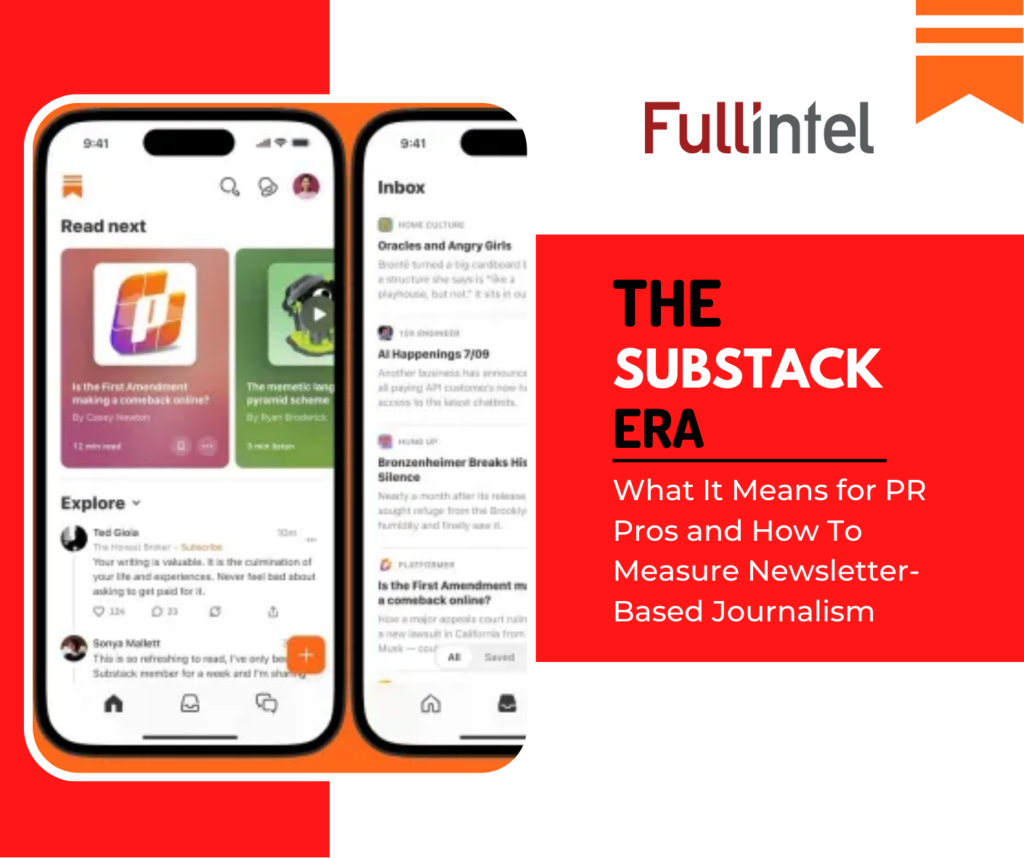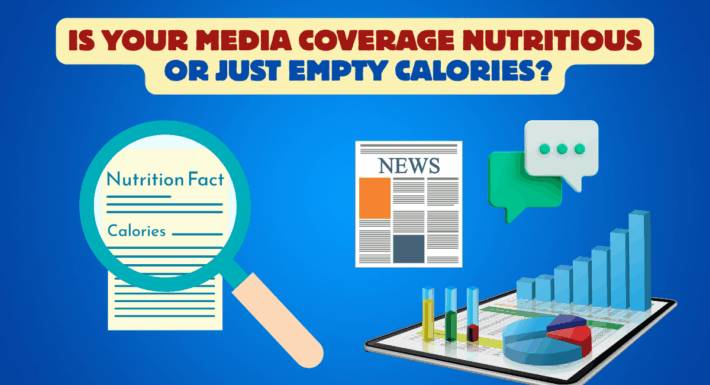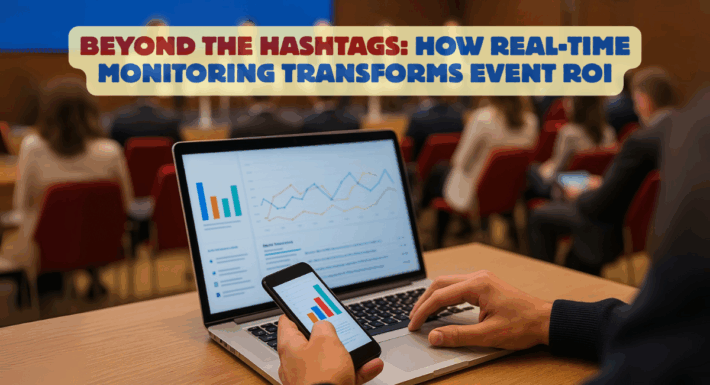The Substack Era: What It Means for PR Pros and How To Measure Newsletter-Based Journalism

Zahra Burton ran her own television news magazine, 18 Degrees North, for years. The hard-hitting show ran investigative journalism-driven items and aired in 27 countries across the Caribbean, North America, and Europe.
But producing a full-on television show eventually became cost prohibitive. So the former Bloomberg reporter decided to go a different route.
“For a long time, I was searching for a platform where I could continue to get my investigative news out (to the public),” she explains in an interview with Fullintel. “And I eventually found Substack.”
Now, the Founder and Principal of Global Reporters for the Caribbean continues to deliver (and monetize) news content to a group of loyal subscribers via her own Substack newsletter, also called 18 Degrees North.
It’s a career option that wouldn’t have been available to her even just a few years ago.
What is Substack?
At this point you’ve no doubt heard of Substack. It’s a subscription network for independent writers and creators that allows anyone to start their own newsletter and, assuming they have an audience, make money from their efforts (Substack’s tagline is “A new economic engine for culture,” and for good reason).
Instead of subscribing to a traditional magazine or newspaper, readers under this model subscribe to newsletters delivered by individual writers.
Substack isn’t the only newsletter option in town, of course – Some Substack alternatives include Mighty Networks, Patreon, and Ghost. Other newsletter options, such as MailChimp, have been used by marketers for years.
Burton says Substack’s main allure out of the gate was how easy it was to set up her own newsletter for free without hiring web developers or other technical support. Substack incentivizes its writers to monetize content but only charges them (a 10 percent fee, plus another 2.9 percent and change to payment facilitator Stripe) when they sign up paid readers.
Substack also offers growth tools for writers who don’t have time for the marketing side of the business.
And it allows newsletter owners to use multiple writers or freelancers (something Burton does for 18 Degrees North, although she is the primary writer and editor). Subtack also offers podcasting and video playback options.
Many writers on the platform (including Burton) publish sponsored content alongside their other creative. And although Substack originally promised it would never have ads, it has reportedly rolled out a recent pilot program to help its creators sell advertising.
Who is On Substack?
While most Substackers don’t necessarily get rich off the platform, some of the most popular Substack newsletters reportedly earn hundreds of thousands or even millions of dollars annually.
History professor Heather Cox Richardson’s Letters from an American is the most popular paid newsletter on the platform, with more than a million subscribers (a fact that makes this history grad very happy).
Interestingly, Cox Richardson doesn’t paywall any of her posts but charges readers to access the comments.
Other popular Substacks include Public, Sinocism, The Mill, Vittles, Nicola Lamb’s Kitchen Projects, Emma Gannon: The Hyphen, House Inhabit, and Blackbird Spyplane.
Why is Newsletter-Based Journalism Important For PR Pros?
Substack and other newsletter-based publishing platforms have grown in importance for PR professionals simply because many journalists – and eyeballs – have migrated there.
Trust in traditional media has also declined precipitously over the past several years, while at the same time, trust in email newsletters has remained relatively constant. A Storydoc report indicates that more than 90 percent of Americans subscribe to at least one email newsletter (and three-quarters subscribe to more than one).
“Publishers are desperately seeking alternative channels to directly engage audiences, where they know their audiences will be guaranteed to see their content and the audience trusts the source,” Jeff Kypietzky, CEO of email newsletter monetization firm Jeeng, told Business News Daily. “This data proves that email fits the bill perfectly for both guaranteed distribution and as a trusted channel.”
While the PR opportunities on Substack were initially sparse due to the nature of many of its early adopters (many of whom focused on politics), this has improved significantly as more content genres have appeared on the platform.
“Search for Substack writers who are relevant to your clients and see whether they have a newsletter you can subscribe to,” advises Trust Relations Founder April Marguiles in PR Daily. “Then, gauge whether they are writing and sharing stories that might be a fit. Substack even offers a feature to help you identify the Substacks of journalists you currently follow on Twitter.”
As for how to pitch to Substack writers? The same rules of engagement apply as any other medium – do your research and don’t blindly pitch journalists irrelevant story ideas.
How To Monitor and Measure Substack?
The most important thing when tracking Substack content is to research in advance which newsletters you want to monitor. Substack is improving at making recommendations and bundling its creators into sections, which helps.
Here’s a step-by-step guide for how to monitor Substack:
1. Decide which Substack newsletters or genre/subject you want to monitor. This is a loaded question because if someone doesn’t already know what they want, a great deal of content on Substack is available for evaluation – which can be a bit overwhelming. As an additional challenge, some of the most popular Substack content is behind a hard paywall).
Because Substack largely works through paid subscriptions per channel, monitoring the entirety of Substack is not realistic. However, you can pick and choose based on suggestions from Substack itself, your own research, or client feedback.
2. Collect the Data: While Substack newsletters have websites that, in theory, can be crawled, Substack is primarily a newsletter platform. That means it sends content by email as soon as it’s published, but all published content also appears on Substack’s web version.
That means collecting substack insights is often a manual exercise involving subscribing to several newsletters.
3. Analyze the Data: PR pros can access publicly available engagement metrics on each article, such as likes and shares, and most newsletters publicly display at least a rough idea of their number of subscribers.
You’ll probably have to contact the writer directly, however, to attain more in-depth engagement metrics such as opens and clicks.
Fullintel Can Monitor and Analyze Any Media Source
Fullintel’s combination of semi-automated media monitoring tools and human curation allows us to monitor any content type, including newsletters from Substack or any provider.
Our trained media analysts do the heavy lifting for you – so you don’t need to spend time manually sifting through dozens of newsletters.
Fullintel’s executive news briefs are trusted news sources for enterprises across dozens of business verticals, and many of our clients read our news briefs (delivered any time of day) each morning instead of visiting news websites directly.
Contact Fullintel today to learn more about how we can help level up your media monitoring and analysis program and empower your corporate communications.




